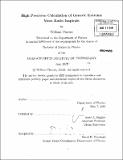High precision calculation of generic extreme mass ratio inspirals
Author(s)
Throwe, William (William Thomas)
DownloadFull printable version (4.568Mb)
Other Contributors
Massachusetts Institute of Technology. Dept. of Physics.
Advisor
Scott A. Hughes.
Terms of use
Metadata
Show full item recordAbstract
Orbits around black holes evolve due to gravitational-wave emission, losing energy and angular momentum, and driving the orbiting body to slowly spiral into the black hole. Recent theoretical advances now make it possible to model the impact of this wave emission on generic (eccentric and inclined) black hole orbits, allowing us to push beyond the handful of constrained (circular or equatorial) cases that previous work considered. This thesis presents the first systematic study of how generic black hole orbits evolve due to gravitational-wave emission. In addition to extending the class of orbits which can be analyzed, we also introduce a new formalism for solving for the wave equation which describes radiative backreaction. This approach is based on a spectral decomposition of the radiation field originally introduced by Mano, Suzuki, and Takasugi (MST), and was then adapted for numerical analysis by Fujita and Tagoshi (FT). We find that the MST-FT formalism allows us to compute various quantities significantly more accurately than previous work, even in strong field regimes. We use this code to explore the location in orbital parameter space of the surface at which the evolution of orbital eccentricity changes sign from negative (orbits circularize) to positive (orbits become more eccentric).
Description
Thesis (S.B.)--Massachusetts Institute of Technology, Dept. of Physics, 2010. Cataloged from PDF version of thesis. Includes bibliographical references (p. 63-64).
Date issued
2010Department
Massachusetts Institute of Technology. Department of PhysicsPublisher
Massachusetts Institute of Technology
Keywords
Physics.